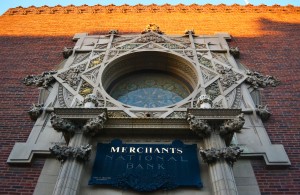By Darwin Manning
manningd@grinnell.edu
One of the brightest gems of Grinnell, considered the “Jewel of the Prairie,” is the Louis Sullivan Bank, which sits at 4th and Broad Street. Sullivan completed the building after ten months of work in 1914. While the structure has gone through several changes in ownership, the foundation has been sound from the beginning, and the bank is a memorable stop for any first-time visitor.

The bank presents a grandiose statement in the heart of downtown Grinnell as one of the Prairie Jewel’s brightest stones. Architect Sullivan deliberately emphasized a cathedral style to reflect the church located across the street. To make the bank fit the aesthetics of the corner, he added 15-foot high by 40-foot wide stained glass windows with various geometric designs.
Additionally, the bricks were constructed in fashion with a Roman style, giving the structure of a bit of a European royal theme. Perhaps the most recognizable gem of this jewel box is the terra-cotta portal, positioned above the Merchants sign. There is also the rose window with a maze of designs. The interior of the bank reflects the extrerior style, with organic terra-cotta interior ornament, a hand-carved wooden check desk and Pink Tennessee marble floors.
“The people who have studied architecture are going to know about this building. It’s probably the best-known building in Grinnell,” said Sheryl Parmley, Chamber of Commerce Membership Manager.
The building of the Louis Sullivan Bank stems from the imagination of Griffin Riker, a member of the board of the glove factory, who wanted a new substantial structure to take the role of the town bank. Riker subsequently commissioned Sullivan to complete the job. Sullivan came to Grinnell in 1913 and first sketched out his plans for the bank before spending $60,000 (in 1913 dollars) and taking the majority of the following year to complete them. On New Year’s Day 1915, the bank had a grand opening, becoming a Grinnell landmark.
The structure was under the ownership of Merchants National Bank until 1924. That year, due to the agricultural depression, the bank was forced to close. However, two years later the bank reopened under the new ownership of Citizens Bank. In 1930, Poweshiek County Bank purchased Citizens Bank. Under the leadership of a few brothers from Des Moines, the bank was renamed and owned by Brenton. This was the title of the Grinnell bank until Wells Fargo purchased it in 2000.
The building has experienced a few structural shifts in the last century. First off, in 1956, the owners substantially remodeled the bank and added wood paneling to the west wall. Two decades later, in 1974, the bank added 12,000 square feet to the north. This addition would, in 1999, be the spot for the relocation of the Wells Fargo bank. That same year, the Grinnell Chamber of Commerce moved into the original location of the bank.
Overall, the bank has required very minor refurbishment, due in large part to the dedicated preservation tactics of the bank’s various owners. The bank did need to have its east windows slightly touched up before RAGBRAI came through two years ago. Additionally, there had to be a new lion made a few years back because one of them was destroyed by vandalism, and now sits in a case within the building. The current owners have maintained this tradition of preservation quite well.
The first glimpse of the mystique of this building in such a quaint town is anything but disappointing. Upon entering, one is immediately transported to a pre-depression period and the world that our grandparents lived in.
“Wells Fargo has done an excellent job with maintaining and it will be around for many more years for people to enjoy,” Parmley said.
Sullivan contributed significantly to the Prairie Studies of Architecture. Sullivan also designed buildings in several other Iowa towns, including Cedar Rapids and Algona. In addition, his portfolio includes structures that can be found in Wisconsin, Minnesota, Indiana and Ohio. The Grinnell building, though, has a special resonance.
“This was the first building out of eight that Sullivan called the jewel box. It has a similar design with the others,” Parmley said.
Though the bank has a prestigious history within the town of Grinnell, the fate of Sullivan was less fulfilling. He struggled with alcohol addiction, which ended up cutting his life short. Sullivan had previously had a strong mentoring relationship with Frank Lloyd Wright, but the relationship soured. Despite the deterioration of their relationship, Wright wound up paying for Sullivan’s funeral. Still, Sullivan’s legacy remains in the many famous banks, including our own jewel box.

































































